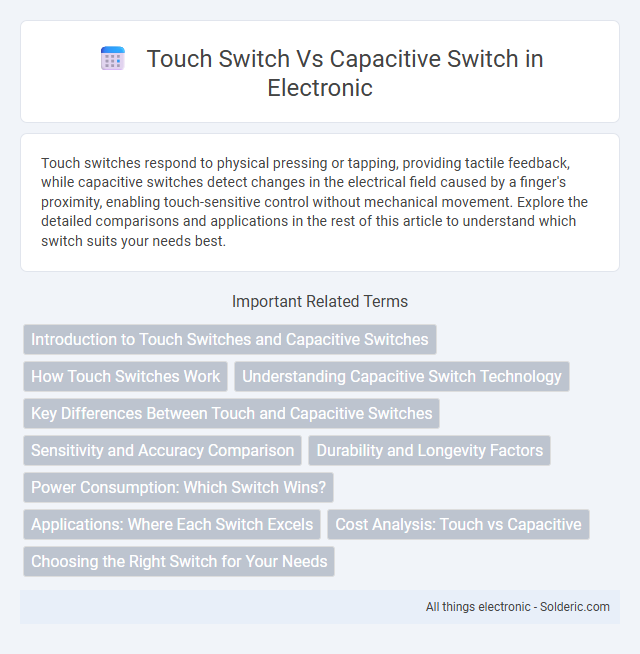Touch switches respond to physical pressing or tapping, providing tactile feedback, while capacitive switches detect changes in the electrical field caused by a finger's proximity, enabling touch-sensitive control without mechanical movement. Explore the detailed comparisons and applications in the rest of this article to understand which switch suits your needs best.
Comparison Table
| Feature | Touch Switch | Capacitive Switch |
|---|---|---|
| Operation | Detects physical touch or pressure | Measures change in capacitance from finger proximity |
| Sensitivity | Moderate, requires direct contact | High, responds to light touch or near approach |
| Durability | Good, mechanical components may wear | Excellent, no moving parts |
| Response Time | Fast | Faster, near-instant |
| Common Uses | Keyboards, touchscreen buttons | Smartphones, home automation, industrial controls |
| Cost | Generally lower | Higher due to advanced sensors |
| Water Resistance | Limited, affected by moisture | High, works through glass and plastic surfaces |
| Power Consumption | Low to moderate | Low, energy efficient |
Introduction to Touch Switches and Capacitive Switches
Touch switches operate by detecting physical pressure or mechanical contact, triggering an electrical response when pressed, making them ideal for straightforward on/off functions in appliances and industrial controls. Capacitive switches sense changes in the electrical field caused by the proximity or touch of a finger, offering a sleek, durable, and reliable interface widely used in consumer electronics and smart devices. Both technologies enhance user interaction, but capacitive switches provide superior sensitivity and resistance to wear, supporting seamless touch commands without mechanical parts.
How Touch Switches Work
Touch switches operate by detecting changes in electrical capacitance when your finger comes into contact with or nears the sensor surface. Unlike mechanical buttons, these switches use an electrostatic field to sense touch input without requiring physical pressure. This technology enables faster response times, increased durability, and seamless integration into sleek modern devices.
Understanding Capacitive Switch Technology
Capacitive switch technology operates by sensing changes in the electrical field caused by the touch of a finger, enabling highly sensitive and reliable activation without mechanical movement. Unlike traditional touch switches that rely on physical pressure, capacitive switches detect the conductivity of your skin to trigger a response, offering enhanced durability and faster reaction times. Your devices benefit from this technology through improved user experience, lower wear and tear, and increased resistance to dirt and moisture.
Key Differences Between Touch and Capacitive Switches
Touch switches detect physical contact or pressure to activate, relying on a mechanical or resistive mechanism, whereas capacitive switches sense changes in electrical capacitance caused by the proximity of a finger without requiring physical force. Capacitive switches offer higher durability and faster response times due to their non-mechanical nature, making them suitable for sleek, modern interfaces. Key differences include sensitivity to touch, with capacitive switches supporting multi-touch and gesture controls, while touch switches typically respond to single presses through direct contact.
Sensitivity and Accuracy Comparison
Capacitive switches offer higher sensitivity by detecting changes in the electrostatic field, enabling precise and responsive activation with minimal pressure. Touch switches, often resistive-based, require physical pressure, resulting in lower sensitivity and less accuracy in distinguishing between intentional and accidental touches. This makes capacitive technology ideal for applications demanding fast and accurate user input detection.
Durability and Longevity Factors
Touch switches rely on mechanical components that may wear out over time, reducing durability compared to capacitive switches that have no moving parts and thus offer enhanced longevity. Capacitive switches resist dust, moisture, and environmental factors better, contributing to a longer operational lifespan. Industrial-grade capacitive switches often guarantee millions of activation cycles, surpassing the typical durability of touch switches.
Power Consumption: Which Switch Wins?
Capacitive switches generally consume less power than traditional touch switches because they detect changes in capacitance with minimal current flow. Touch switches often rely on resistive elements or mechanical components, leading to higher energy usage during activation. In low-power applications, capacitive switches are preferred for their efficiency and durability.
Applications: Where Each Switch Excels
Touch switches are ideal for applications requiring simple, direct interaction such as home appliances, lighting controls, and kiosks due to their reliable mechanical feedback and ease of installation. Capacitive switches excel in environments demanding sleek, modern interfaces and multi-touch capabilities, commonly found in smartphones, tablets, and advanced control panels, offering enhanced durability and sensitivity without mechanical wear. Your choice depends on whether you prioritize tactile feedback and robustness or a seamless, touch-sensitive experience with advanced gesture recognition.
Cost Analysis: Touch vs Capacitive
Touch switches generally cost less than capacitive switches due to simpler technology and lower manufacturing expenses. Capacitive switches offer higher sensitivity and durability but come at a premium price, influenced by the need for advanced sensors and materials. When evaluating your budget, consider that touch switches provide a cost-effective solution, while capacitive switches deliver enhanced performance with a slightly higher investment.
Choosing the Right Switch for Your Needs
Choosing the right switch for your needs depends on factors like sensitivity, durability, and user interaction preferences. Capacitive switches respond to the electrical properties of your skin, offering higher sensitivity and a sleek, touch-sensitive surface ideal for modern devices. Touch switches often rely on pressure, providing tactile feedback but may wear out faster in high-use environments.
touch switch vs capacitive switch Infographic

 solderic.com
solderic.com